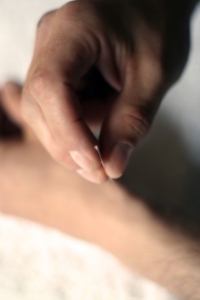
Acupuncture plays with tension.
Acupuncture Explained
Acupuncture started in China during the Han dynasty (206 BCE – 220 CE). It stimulates body points to cause a self-healing response, based on the ancient Chinese concept of Qi (pronounced “chee”).
Qi is the energy linked to all activity in our bodies and may be physical or mental. Acupuncture enhances this energy and promotes normal functions by relieving, or promoting, tension. For tension can either block normal function or be the necessary structure for a well-integrated body.
Our bodies show signs of Qi imbalance before symptoms occur. These signs may appear as changes on the skin, at pressure points, in connective tissue (fascia), in the pulse, and on the tongue. Tongue and pulse diagnosis is the signature of traditional acupuncture treatment.
Acupuncture is effective because it helps us adapt to all types of stress. For we’re stressed not only by our thoughts but also from overwork (or overtraining), injury, pollution, poor diet, and imbalanced lifestyles. All are triggers for broad symptoms that can sometimes be puzzling.
Acupuncture solves even the most puzzling health problems, based on natural science involving detailed observation, experimentation, two millennia of peer review, and consistent results.
Styles Vary
In classical Asian acupuncture, each treatment is unique. The points that are used depend on all data collected through traditional diagnostic techniques. This contrasts a Westernized acupuncture style where common points are selected based on names of diseases rather than on people. While both styles can be effective, Balingit Acupuncture views classical styles as the most effective in causing a holistic self-healing response.
Relying on a rational framework and heuristics, Balingit Acupuncture acts on interactive feedback gained during each acupuncture session, mainly using pulse diagnosis.
Thought Process
Systems thinking is the study of patterns to identify relationships between dynamic elements. Our bodies are systems made of interdependent structures and organs. We cannot treat one part of the body while neglecting the rest, and expect optimal health.
Acupuncture uses the systems thinking approach, accounting for the interplay amongst all the body’s organs, systems and functions.
While the adoption of systems thinking is increasing in healthcare, it has been the mindset of acupuncture practice from the beginning.
Beyond our bodies, we are also part of a larger system of environments and diverse cultures; all of which influence our health.
There are many interacting dynamic systems. San Diego is a subsystem of California, which is a subsystem of the U.S. and, even broader, North America. Each of these systems presents its own culture that influences your healthcare experience.
